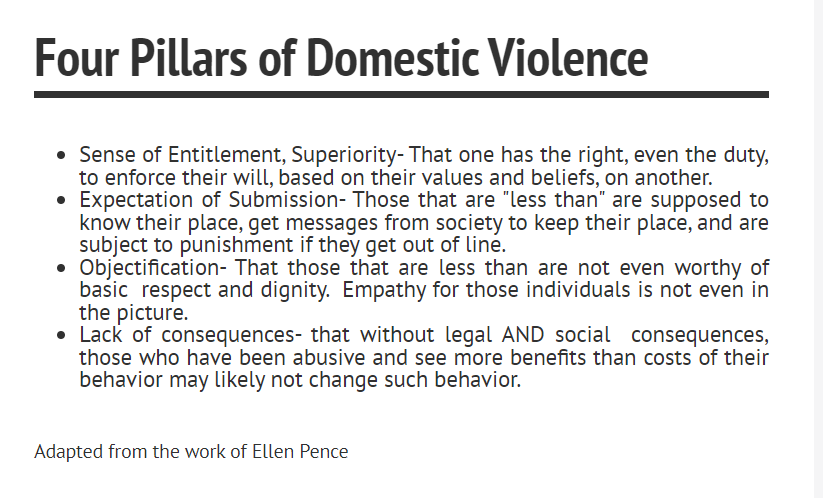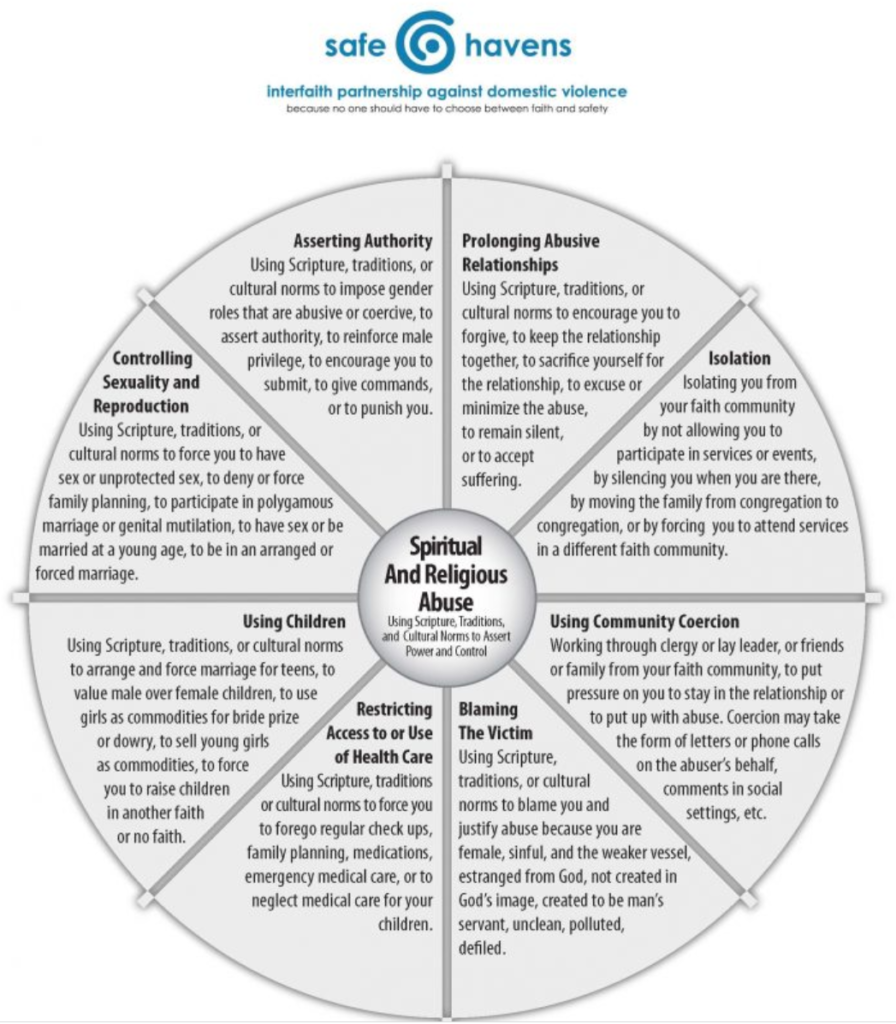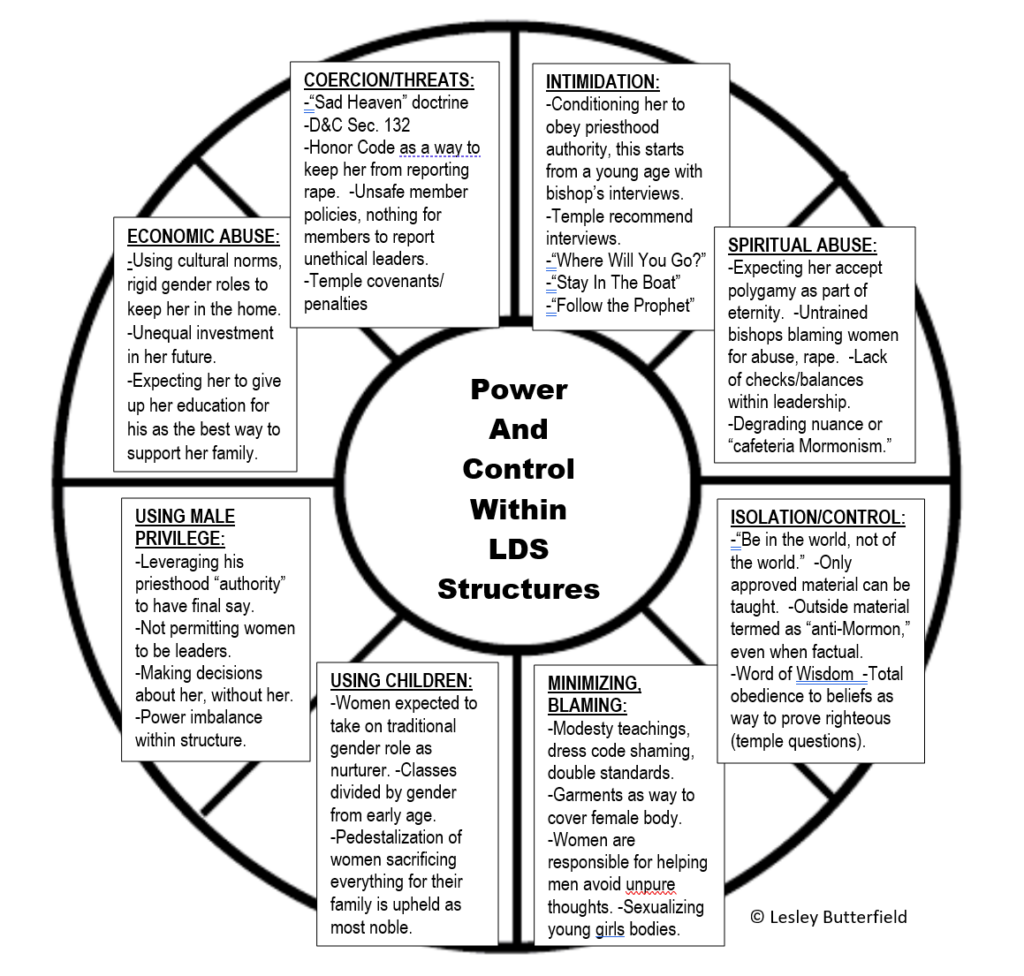Watching the hit series, Under the Banner of Heaven, take liberties to correlate pervasive domestic abuse with uniquely Mormon religious beliefs has seemed to strike an unexpected chord with society at large. Except it’s not unexpected at all—at least not for those members who have encountered the garden variety of similar situations portrayed—entitled male church leaders, spiritually coercive spouses, run-of-the-mill situations of dress code shame, even abuse that has gone unrecognized, unaddressed, and unpunished within the walls of very our own church. It’s also certainly *not* just some random fundamental flavor of offshoot Mormonism where these conclusions can be so neatly packaged. It is, however, what many marginalized members experience within mainstream Mormonism.
Correlations Between Domestic Abuse and Mormonism
It may help to illustrate the correlation by looking at the research of domestic violence activist, Ellen Pence, which identifies four main pillars of domestic violence. Pence’s research has largely been adopted by all 50 states, as well as within programs serving victims of abuse. Pence identified fours pillars of domestic abuse:

Pence’s work led to the creation of the iconic Power and Control Wheel, shown here:

Domestic Abuse Can Exist Within Many Religious Systems
The power and control wheel can easily translate into faith communities, as religious and spiritual abuse is something that has become more widely recognized as awareness increased around the issue in general. Below is a power and control wheel for a non-specific religion and/or faith community:

What does this have to do with the beliefs and tenets of mainstream Mormonism?
Everything. And then some.
It goes without saying that one won’t have to look hard to find Mormon doctrine sprinkled with communally understood rules robust with these same pillars of abuse that Pence identified. Perhaps what Banner does best, is paints a picture of the exact mechanisms, right down to the doctrinal references and cultural idiosyncrasies that exist within the Mormon framework to allow such obvious domestic abuse to hid in plain sight, under the guise of spiritual necessity. Or should we say, under the banner of heaven itself.
How Can Mormon-centric Religious Beliefs Be Abusive?
Mormon-specific intricacies existing even within the most important of its doctrines and widely observable within the insular but well-meaning, and by vast accounts, charitable community create an almost indistinguishable power and control wheel that conflates itself with the very pillars that the religion was founded and built upon. To say it is confusing to try to identify how these mechanisms can cause harm in the way of domestic abuse to those vulnerable within the flock is an understatement. The lay member will see these principles as the very mechanisms that are essential to upholding the beliefs of their dearly held religion—it is quite a leap to convince a faithful member that their beliefs can actually be harmful in the way of abuse to another.
Looking again at the four pillars of domestic violence, this time through the lens of mainstream Mormonism:
4 Pillars of Domestic Abuse Within Mormonism:
- Sense of Entitlement/Superiority-Any member would be familiar with phrases: Chosen Land, Promised Land, a choice line, chosen people, Presiding Authority, Priesthood authority, patriarchal order. The ethnocentric nature of missionary work and declaring it our place as members of the church to engage in saviorism for all of humanity, leans on unhealthy views of our own inflated Exceptionalism. We assume to be the “one true church.” Additionally, part of Mormonism’s deepest doctrine is that men can someday become Gods themselves–a principle that surely enables a sense of superiority. The church has yet to unpack the problematic nature of these practices because of the entitlement enveloped within the very keystones of its foundation.
- Expectation of Submission-Doctrine & Covenants Section 132, which is riddled with clear, undeniable spiritually abusive language contains directives of the expectation of female submission. It not only has yet to be denounced by our leaders but it is canonized as part of the standard works. And yet, the church cannot or will not recognize the (huge) problems that exist when men operate with entitlement and women feel they have no choice but to submit?
- Objectification-Dress codes, covering of shoulders and knees is expected even of young girls, unnecessarily perpetuating the sexualization of the female body, prepubescent at that. But viewing/treating females as an object, devoid of thought or feeling goes beyond dress codes—it also is systemically sewn within the structure of the church itself. Women are not permitted to hold leadership positions—at least not the kind where they don’t also answer to a man. They are functionally objects within the framework and exist to function for the community, for the men. The litmus test is simple: if not true, let the women start freely leading themselves and leading the men too.
- Lack of consequences-Not only do cultural implications or otherwise, seemingly do not exist for abusive male members, but these situations have more recently become known to even be enabled by church leaders and/or hidden by church legal. Furthermore, a widely observable trait is the inability and the unwillingness that leaders, the community, the structure and the policies simultaneously possess to stubbornly refuse to hold any abuser accountable. The doctrine of forgiveness frequently acts a convenient mechanism for bypassing perpetrator consequence, while placing victim’s emotional and physical safety last. There is no recourse for members to report unethical church leaders, except to go to their own bishop—highly problematic if the bishop *is* perpetrator or has enabled the very abuse himself—another issue with “lay leaders” that have no formal training and only the spirit to guide them.
Domestic Abuse Can Be Exacerbated By Mormon Beliefs
Part of the difficulty with Banner is that it attempts to show how uniquely Mormon beliefs can lead to uniquely horrific situations involving unimaginable abuse and violence with religious underpinnings being the glue that holds it all together. Members who have never experienced how these same religious beliefs can go terribly awry or even be used as a way to coerce another may have a hard time understanding how this happens or even that this happens. Additionally, they may think this is an issue that is unique only to branches of fundamental Mormonism. But, as many women within the mainstream Mormon church have said, the abuse they have experienced was exacerbated by seemingly “innocent” mainstream beliefs. Furthermore, taking these pillars and translating them into a power and control wheel, specific to the LDS structure, may look something like this:

After watching Banner, viewers seem to ask: Does Mormonism make men abusers? That may be the wrong way to look at it. The question should be: How do male abusers find a home within Mormonism?
The answers are easy: they are found within the doctrine that enables their entitlement, they are found within the culture that expects female submission, they are found within the beliefs that permit them to objectify women, and they are found within the structure that offers them safety and security no matter what.
They find a home within Mormonism because Mormonism is their home. The principles of their religion are the same principles of their abuse. For abusers, these things are conflated and not differentiated in any way.
We know this: Abusers will exist inherently within every system of faith and society at large for that matter. What is important, and inarguably, crucial to examine, is how do they exist so comfortably, so justifiably, within our system of faith?
While Banner makes for good entertainment and thought-provoking theories, undoubtedly some members of the LDS faith are likely grappling with a reckoning. Seeing their own faith so accurately portrayed with all its problematic idiosyncrasies and concerning cultural dynamics, they may start to ask: Where is the line between religious beliefs and abusive pillars?
Or is there a line at all?





Recent Comments